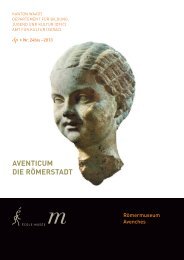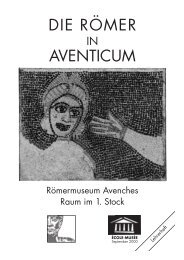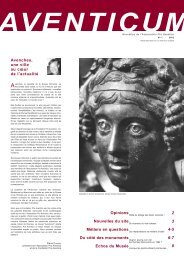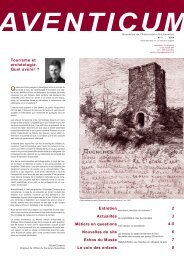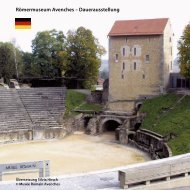Avenches – Roman Museum – Permanent Exhibition
Avenches – Roman Museum – Permanent Exhibition
Avenches – Roman Museum – Permanent Exhibition
You also want an ePaper? Increase the reach of your titles
YUMPU automatically turns print PDFs into web optimized ePapers that Google loves.
Second Floor Food<br />
Drinking and Eating<br />
68. Bunch of grapes made of bronze.<br />
69. Bronze authepsa, used to keep liquids warm by putting hot coal into its interior<br />
compartment.<br />
70-72. Square glass bottles.<br />
73-75. Neck and handle of glass bottle.<br />
Food<br />
The <strong>Roman</strong> period differed from previous times because of the abundance and<br />
diversity of foods available. North of the Alps, however, the staple diet was still<br />
cereals, vegetables and legumes.<br />
A Big Market<br />
With the <strong>Roman</strong> conquest, new types of food, which were rare and unknown to<br />
the indigenous population, appeared on the local markets. These were mainly<br />
luxury products coming from distant regions. Oysters were imported from the<br />
Mediterranean or Atlantic coasts; olive oil, olives, fish and shellfish-based sauces,<br />
mackerel, figs, dates, pine kernels, and pomegranates originated from different<br />
Mediterranean countries as well as nuts and grapes, which were grown locally<br />
probably from the 1 st century AD onwards. Cinnamon, pepper, ginger, cardamom,<br />
aniseed, oriental caraway, sesame, and rice <strong>–</strong> all these products were imported from<br />
India, Arabia or Ethiopia.<br />
Drinking and Eating<br />
The main cereals grown locally were barley, spelt, millet and wheat. These provided<br />
flour for baking wafers and bread or for preparing porridge (puls).<br />
Most people cooked with animal fat (lard) or, less frequently, with butter. Olive oil,<br />
imported in large quantities from southern Spain, was mainly used by wealthy people.<br />
However, oil produced locally from linseed or poppy seed was still used as well.<br />
Honey was used to sweeten food, especially for baking cakes and pastry as well<br />
as for preparing various sauces. The dishes were often spiced with aromatic sauces<br />
(garum) based on fish and shellfish pickled in salt. Salt came from saline springs or<br />
rock salt mines; along the coastlines sea salt was used.<br />
Coriander, aniseed, celery and indigenous caraway were the most frequently<br />
used spices and aromatic plants in this region. There is little evidence of fennel, pine<br />
kernels, wild basil, mustard, poppies and garlic as well as marjoram / oregano, wild<br />
thyme, verbena and mint.<br />
With the arrival of the <strong>Roman</strong>s wine quickly became popular, but beer, the<br />
traditional Gaulish beverage, remained much appreciated in this region. The most<br />
widespread and renowned type was barley ale based on spelt. They also drank mead,<br />
a beverage made of fermented wheat, water and honey.<br />
1<br />
2<br />
57<br />
Second Floor<br />
8



